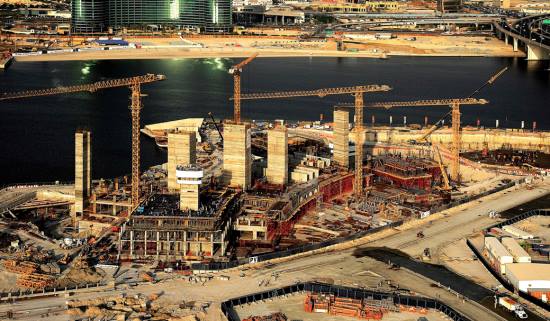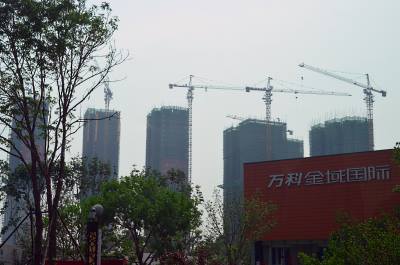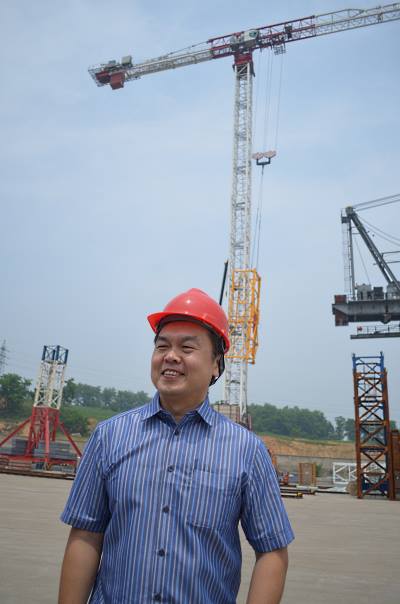 Yongmao's flat top tower cranes deployed at the Dubai Turf City project. The company's products are exported to over 70 countries worldwide. Company photo
Yongmao's flat top tower cranes deployed at the Dubai Turf City project. The company's products are exported to over 70 countries worldwide. Company photo
Visuals by Sim Kih unless otherwise indicated.
 On the drive to Yongmao's facility in Fushun, we passed a construction site belonging to Vanke, China's largest residential property developer. Each tower block has a tower crane installed. Tower cranes adjacent to blocks under construction are a common sight in China's urban districts.Together with reporters from Business Times and Shares Investment magazine, as well as an investment analyst from OSK-DMG, NextInsight recently had the privilege of visiting one of the best tower crane manufacturing facilities in China.
On the drive to Yongmao's facility in Fushun, we passed a construction site belonging to Vanke, China's largest residential property developer. Each tower block has a tower crane installed. Tower cranes adjacent to blocks under construction are a common sight in China's urban districts.Together with reporters from Business Times and Shares Investment magazine, as well as an investment analyst from OSK-DMG, NextInsight recently had the privilege of visiting one of the best tower crane manufacturing facilities in China.
Located in Fushun, Liaoning, China, the facility is owned by SGX-listed Yongmao Holdings.
Yongmao's investment story revolves around its dominant market position in an industry that is increasingly thriving on China's rapid urbanization.
Urbanization has been skyrocketing in China - from 18% in 1978 to 54% last year. In other words, China's cities are already home to more than half of its population.
The flurry of construction activities spreading across China has become an inevitable long term trend.
To catch up with the 80% average urbanization rate of developed nations, China is targeting an urbanization rate of 60% by 2020, and that is just 6 years away.
Tower cranes dominate in China
"Tower cranes are very popular in China because they are more cost effective than crawler cranes," said Yongmao's executive director Sun Tian.
He was speaking to the Singapore delegation at Yongmao's headquarters in Fushun on 16 June.
"PRC construction contractors are highly cost conscious and prefer tower cranes because crawler cranes usually cost 3 to 4 times as much," he added.
The higher cost is due to the fact that the crawler crane is a heavy-lift equipment assembled on an automobile vehicle, whereas the tower crane does away with the automobile.
"Crawler cranes are seldom seen at construction sites in China," added Sun Tian.
 Executive director Sun Tian has lived in Singapore since his secondary school days having been educated here. He is Sun Zhaolin's son and heir apparent to Yongmao's business.Pricing strategy
Executive director Sun Tian has lived in Singapore since his secondary school days having been educated here. He is Sun Zhaolin's son and heir apparent to Yongmao's business.Pricing strategy
Yongmao's tower cranes are the most expensive in China but for good reason.
"Even though our cranes are pricier than those from other local manufacturers, there has been increasing demand over the years because construction contractors are becoming more discerning in equipment choice," said Sun Tian.
"Construction contractors these days are often graduates of tertiary education institutions.
"The well-educated tend to be more fastidious in their choice of equipment, " said Sun Tian.
Control over the pricing range of Yongmao cranes is part of the Group's sales strategy.
Price points of brand new Yongmao cranes are kept high in order to give customers a good resale value for their used cranes.
One can find numerous advertisements for used Yongmao cranes going for up to US$100,000 on Alibaba.
Nonetheless, Germany's Liebherr remains the Rolls Royce of all cranes. A Liebherr crane can be 80% more expensive than a Yongmao crane of the same class.
Being in China is a comparative advantage because of its lower production cost relative to Europe.
Thus, Yongmao is generally able to price its products lower than its European competition.
Yet, the superior quality of Yongmao cranes means there are times when a Yongmao crane is priced higher than an European model.
The quality of made-in-China cranes have over the years become increasingly comparable to European products.
Dominant position in China's nuclear power industry and in Singapore
Needless to say, the company has won numerous awards in China. It is acknowledged by industry insiders to be one of China's top 3 tower crane manufacturers.
Global construction companies have used Yongmao tower cranes to build iconic landmarks around the world, such as the Beijing National Stadium, the Imperial Wharf in London, and the Gold Coast University Hospital in Australia.
| Video by lclun: Yongmao's tower cranes climbing inside a building. Yongmao is one of the top 3 tower crane manufacturers in China. |
About 30% of Singapore’s new tower cranes and almost 90% of China's nuclear power plant construction cranes were supplied by Yongmao.
"We have such a large market share for nuclear power stations because we were able to customize our cranes," said Sun Tian.
As there is a huge pollution problem in China, the government wants to convert a significant amount of coal powered production to nuclear power.
China's nuclear power industry holds huge potential for Yongmao as the industry is still in its infancy.
Construction of nuclear stations in China resumed only last year after the scare caused by Japan's tsunami disaster in 2012.
Being the only crane supplier officially approved by the PRC department of nuclear power, Yongmao is in a sweet spot.
In China, it takes about 4 years to construct one nuclear power station. One small nuclear station needs at least 5 cranes. A large power station will need at least 20 cranes.
That is not to say Yongmao is only present in China and in Singapore. It exports to over 70 countries worldwide.
"Every year, we try to develop one new growth market," said Sun Tian.
"We took almost 3 years to develop our presence in Russia," he added.
Strong demand from Russia had contributed to the strong surge in FY2014 sales to North America and Europe (up 133.8% year-on-year at Rmb 41.9 million).

CFO Yap Soon Yong with Yongmao's large flat top tower crane in the background.Growth capacity
Yongmao sells more than 600 cranes every year.
A large customized luffing tower crane can sell for close to S$5 million (Rmb 20 million).
Its Fushun facility has capacity to produce more than 400 cranes a year while its Beijing facility can produce about 300 smaller cranes.
"Actual production capacity numbers really depend on the crane sizes," said CFO Yap Soon Yong.
Large cranes command better margins
Yongmao specializes in large tower cranes.
Its crane lift load typically ranges from 8 to 10 tons for its smaller cranes, all the way to a super crane customized to handle 100 tons.
In comparison, the average lift load for Zoomlion (China's largest construction machinery manufacturer) is 6 to 8 tons.
"Our gross margins have improved over the years as we are selling larger and larger cranes," said Sun Tian.
"Larger cranes command higher margin.
"Tat Hong, which accounts for about 30% of our revenue, is also moving away from the smaller cranes."
(SGX-listed Tat Hong and Yongmao have cross shareholdings in each other. Tat Hong holds 23.95% in Yongmao while Yongmao holds 11.6% in Tat Hong's China operating subsidiary.)
In FY2014, Yongmao's gross margin expanded by 1.9 percentage points year-on-year to 27.3%, thanks to higher sales of higher margin luffing tower cranes in Asia.
The company only deals with large construction contractors, equipment distributors and equipment rental companies as the smaller players cannot afford to purchase high-end construction equipment.
Watch out for part two of our plant visit report - on Yongmao's superior manufacturing.
Recent story: YONGMAO, SIN HENG, TAT HONG: Which Crane Player To Bet On?








We have Yongmao Luffing Cranes in operation.
It would be of great assistance to us if you could furnish us with details of the correct wire Rope to be used.
Thank you & Regards,
Subas
+60172187360
subas_boy89@yahoo.com